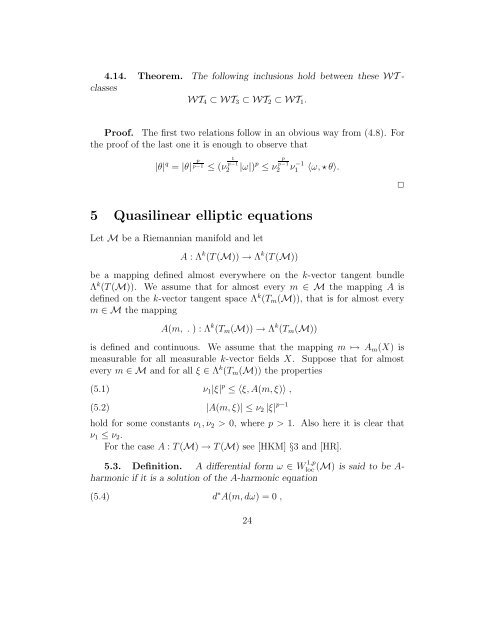5 Quasilinear elliptic equations
5 Quasilinear elliptic equations
5 Quasilinear elliptic equations
You also want an ePaper? Increase the reach of your titles
YUMPU automatically turns print PDFs into web optimized ePapers that Google loves.
4.14. Theorem. The following inclusions hold between these WT -<br />
classes<br />
WT4 ⊂WT3 ⊂WT2 ⊂WT1.<br />
Proof. The first two relations follow in an obvious way from (4.8). For<br />
the proof of the last one it is enough to observe that<br />
|θ| q = |θ| p<br />
p−1 ≤ (ν 1<br />
p−1<br />
2<br />
|ω|) p ≤ ν<br />
p<br />
p−1<br />
2<br />
5 <strong>Quasilinear</strong> <strong>elliptic</strong> <strong>equations</strong><br />
Let M be a Riemannian manifold and let<br />
A :Λ k (T(M)) → Λ k (T (M))<br />
ν −1<br />
1 〈ω, ⋆ θ〉.<br />
be a mapping defined almost everywhere on the k-vector tangent bundle<br />
Λ k (T (M)). We assume that for almost every m ∈Mthe mapping A is<br />
defined on the k-vector tangent space Λ k (Tm(M)), that is for almost every<br />
m ∈Mthe mapping<br />
A(m, . ):Λ k (Tm(M)) → Λ k (Tm(M))<br />
is defined and continuous. We assume that the mapping m ↦→ Am(X) is<br />
measurable for all measurable k-vector fields X. Suppose that for almost<br />
every m ∈Mand for all ξ ∈ Λ k (Tm(M)) the properties<br />
(5.1)<br />
ν1|ξ| p ≤〈ξ,A(m, ξ)〉 ,<br />
|A(m, ξ)| ≤ν2|ξ| p−1<br />
(5.2)<br />
hold for some constants ν1,ν2 > 0, where p>1. Also here it is clear that<br />
ν1 ≤ ν2.<br />
For the case A : T (M) → T (M) see [HKM] §3 and [HR].<br />
5.3. Definition. A differential form ω ∈ W 1,p<br />
loc (M) is said to be Aharmonic<br />
if it is a solution of the A-harmonic equation<br />
(5.4)<br />
d ∗ A(m, dω) =0,<br />
24<br />
✷
understood in the weak sense, that is<br />
�<br />
(5.5)<br />
〈A(m, dω),dΦ〉dvM =0<br />
M<br />
for all differential forms Φ ∈ W 1,q<br />
loc (M) with supp Φ∩∂M = ∅, 1/p+1/q =1.<br />
5.6. Theorem. A differential form ω ∈ W 1,p<br />
loc (M) is A-harmonic with<br />
properties (5.1) and (5.2) if and only if dω ∈WT2.<br />
Proof. Let ω, degω=k, be a solution of (5.4) understood in the weak<br />
sense. Let the differential form α(m) be associated with the vector field<br />
A(m, dω) atthepointmand set θ = ⋆α. The differential form ω is weakly<br />
closed because of (5.5) and the weak closedness of θ follows from<br />
(−1) nk+1<br />
�<br />
〈θ, d ∗ �<br />
ψ〉 dvM = 〈⋆α,⋆d⋆ψ〉dvM<br />
M<br />
=<br />
=<br />
M<br />
�<br />
M<br />
�<br />
M<br />
〈α, d ⋆ ψ〉 dvM<br />
〈A(m, dω),dφ〉dvM =0<br />
for all ψ = ⋆ −1 φ ∈ W 1,q (M) with supp ψ ∩ ∂M = ∅. It remains to verify<br />
(4.6) and (4.7). From (5.1) it follows that<br />
and from (5.2)<br />
ν1|dω| p ≤〈dω, A(m, dω)〉 = 〈dω, ⋆ θ〉<br />
|θ| = | ⋆α|=|A(m, dω)| ≤ν2|dω| p−1 .<br />
Conversely, if dω ∈WT2, then there exists a weakly closed differential form<br />
θ (see (4.3)) such that (4.6) and (4.7) are satisfied. With the vector field<br />
a : M→Λk(IR) associated to the differential form α = ⋆θ we define<br />
�<br />
a(m) for ξ = dω(m) ,<br />
A(m, ξ) =<br />
ξ|ξ| p−2 for ξ �= dω(m) .<br />
The weak closedness of θ ensures that ω is a solution of (5.4) understood in<br />
the weak sense. The conditions (5.1) and (5.2) for A are satisfied because of<br />
(4.6) and (4.7). ✷<br />
25

















